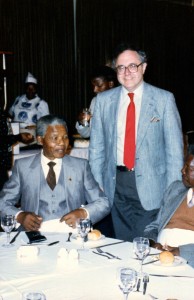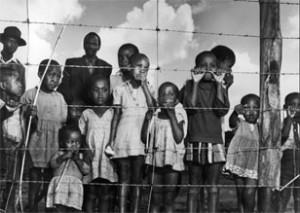IU’s South African connections run deep
As the IU delegation leaves behind sunny and mild Johannesburg for rainy and cool Cape Town, it gives me a moment to reflect on a number of interesting IU-South Africa connections that I’ve picked up both before and during this presidential trip.
Almost every South African we’ve talked to thus far—whether it be the administrators and faculty at the Gordon Institute of Business Science in Johannesburg or South Africa’s minister of higher education and training, whom we met yesterday in Pretoria, has been extremely impressed to learn of IU’s longstanding history of educational engagement and institution-building here in South Africa.

IU Vice President Emeritus and South African native Patrick O’Meara with South African revolutionary Nelson Mandela.
It’s a history that spans a wide range of academic, cultural and legal activities, perhaps none more impressive than IU’s from-the-ground-floor involvement in the establishment of Khanya College, one of South Africa’s greatest academic success stories.
In 1986, the South African Council on Higher Education (SACHED) formed Khanya College to assist talented black students who wished to pursue a university education, but, due to their disadvantages, were having difficulty obtaining entrance to South Africa’s leading universities.
That same year, IU became involved in Khanya, joining forces with SACHED to provide preparatory first-year university courses for black South Africans who demonstrated potential for pursuing an undergraduate degree. Working with faculty and tutors from South Africa, IU faculty developed undergrad courses—modeled after the university’s successful Independent Study Program—in economics, history, literature, mathematics, physics, psychology and sociology. Those same faculty graded the South African students’ major assignments and final exams, and those students who successfully completed the courses received an IU transcript. That IU transcript enabled them to gain admission to the top universities in South Africa, such as the University of Cape Town, which the IU delegation will visit later this week, and Witwatersrand University, known locally as “Wits.”
According to IU Emeritus Vice President Patrick O’Meara, a native South African who directed IU’s acclaimed African Studies Program at the time (read about his visit with Nelson Mandela), at various points more than 100 Khanya students were enrolled in these courses each year. In the first three years alone, more than 400 students completed the IU course of study. In addition, John Samuel, the head of Khanya College, visited IU on different occasions. Former IU President Thomas Ehrlich went to Khanya College in 1990, and IU faculty members and a number of Khanya faculty and administrators also made reciprocal site visits.
By the mid 1990s, IU had sufficiently trained Khanya faculty and staff, so that their South African colleagues could take over the college’s operations. Khanya College still exists today, though its mission has changed since the end of apartheid, South Africa’s national system of racial segregation that began in 1948 and wasn’t officially abolished until 1990. Today, the college contributes to the strengthening of community-based organizations, unions and non-governmental organizations with programs and other activities to foster social change and development.
Despite phasing out its participation in Khanya College, IU continued its involvement in South African education in the years to follow. Almost immediately after the end of apartheid, IU and Wits launched an initiative to improve the retention of Wits’ black South African students. As part of the initiative, which was funded for three years (1992-94) by the U.S. Information Agency’s University Affiliations Program, IU made available opportunities and programs for South African professionals in such areas as counseling, guidance and skills-learning.
Helping to address a great need in South Africa for skilled professionals with experience in writing laws, IU spearheaded the creation of the Legislative Drafting Program for South Africa in partnership with the University of Pretoria, which the IU delegation visited yesterday in an effort to re-ignite collaborative efforts between the two institutions. The project helped train more than 70 mid-level professionals over a three-year program that included service-learning training in South Africa; internships in the U.S.; video-conferencing technology for lectures and consultations; professional visits to Washington, D.C., for South African trainers involved in the certificate program; and the establishment of a consulting network of Indiana academic and legislative professionals.
In the mid-to-late 1990s, IU ran two hugely successful internship programs, including a regional internship program that brought two dozen mid-career professionals to the U.S. from the countries of Zimbabwe, Botswana and Malawi for eight-week internships. Through the other program, IU placed more than 200 professionals from South Africa in arts, business, education, government, law, media, public health and social service internships in cities all across the U.S.
IU’s political and cultural connections to South Africa run especially deep. On our way into Cape Town, I couldn’t help but notice road signs for the Helen Suzman Boulevard, one of two newly renamed boulevards in the city (the other is for Nelson Mandela). An anti-apartheid activist and member of the South African parliament, Suzman, who died in 2009, visited IU Bloomington on three occasions, and, in 1992, served as a distinguished citizen fellow at the IU Institute for Advanced Study. That same year, she was IU Bloomington’s commencement speaker and received an honorary doctorate.
The Nadine Gordimer collection in the IU Lilly Library consists of the papers of the acclaimed South African writer and winner of the 1991 Nobel Prize in Literature. The collection of 6,700 items includes correspondence with her colleagues, literary agents and publishers, and with magazines in which many of her short stories first appeared. It also features draft and final versions of her stories, articles, book reviews, novels, short story collections, speeches and story ideas, as well as a diary Gordimer kept when she was 11. Additionally, the Lilly Library houses a collection of 1,200 items relating to the distinguished South African playwright Athol Fugard.

A new exhibition at IU Bloomington’s Mathers Museum of World Cultures will feature rarely seen apartheid-era images by famed “Life” photographer Margaret Bourke-White.
IU’s Black Film Center/Archive features much of the life’s work of Peter Davis, including his unique film records of South Africa before the end of apartheid. Among the nearly 2,000 reels and 40 boxes of notes, research, photographs and outtake stills are materials related to “White Laager,” a film on the history of the Afrikaner people, “Generations of Resistance,” a film on African nationalism, and two documentaries on Nelson and Winnie Mandela.
Finally, I’m most excited about an upcoming exhibition I had a chance to quickly preview the day before leaving Bloomington for South Africa. The exhibition, which will be on display next month and through the fall semester at the Mathers Museum of World Cultures, will feature rarely seen apartheid-era photos by famed “Life” photographer Margaret Bourke-White. Curated by IU associate professor of history Alex Lichtenstein, the exhibition showcases some striking, never-before-seen photographs Bourke-White took during a visit to South Africa in 1950. Following a semester in Bloomington, it will travel, in 2014, to the Bensusan Museum of Photography, Museum Africa, in Johannesburg and the Michaelis Galleries at the University of Cape Town.
Conveniently, the exhibition will open (Sept. 6) just as the IU delegation is returning from its two weeks in Africa, making it one more necessary South African-related stop on an already amazing journey through IU’s deep-rooted connections to this dynamic part of the world.
Tags: Alex Lichtenstein, apartheid, Athol Fugard, Cape Town, GIBS, Gordon Institute of Business Science, Helen Suzman, IU African Studies Program, IU Black Film Center/Archive, IU Lilly Library, Johannesburg, Khanya College, Legislative Drafting Program for South Africa, Margaret Bourke-White, Mathers Museum of World Cultures, Nadine Gordimer, Patrick O'Meara, Peter Davis, SACHED, South Africa, University of Cape Town, University of Pretoria, Wits, Witwatersrand University

